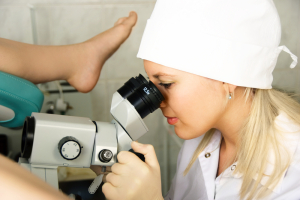Diagnosis Of Cancer
How is a diagnosis of cancer made? The cancer symptoms that are described in detail in each of the separate organ specific cancer chapters suggest that there might be an underlying cancer; but how does the physician pinpoint that there is an underlying cancer?
The doctor will do cancer tests, which will diagnose that cancer is present or the tests will rule it out. Often there are more non-specific cancer tests like the blood in stool test that may be useful for screening. But if the test is positive for blood, the doctor will refer the patient for a more specific test, a colonoscopy, to a gastroenterologist or surgeon to zero in on the specific diagnosis.
To complete this example, if the colonoscopy confirms a cancerous polyp, the doctor will likely examine the patient carefully to rule out an enlarged liver, fluid in the abdomen (ascites) and do some more blood tests to rule out liver metastases by checking liver enzymes and doing more specific cancer blood tests such as the carcinoembryonic antigen (CEA). Other tests such as a liver ultrasound and a bone scan might be ordered, depending on the clinical situation.
In this example there might only be the finding of the cancerous polyp in the large intestine, but no positive other tests to indicate that there are no metastases. This would be a case of a localized Duke A stage colon cancer with a 5-year survival rate of 91% following local surgery.
Details of cancer staging can be found in the various cancer chapters (click on links below).
References:
1. JK McLaughlin et al. Int J Cancer 1995 Jan 17; 60(2): 190-193.
2. GN Wogan Semin Cancer Biol 2000 Jun 10(3): 201-210.
3. L Garfinkel et al. Stat Bull Metrop Insur Co 1999 Jul-Sep;80(3): 23-32.
4. G Torres-Mejiha et al. Int J Cancer 2000 Sep 15;87(6): 869-873.
5. M Feuring-Buske et al. Ann Hematol 2000 Apr 79(4): 167-174.
6. RJ Kreitman et al. J Clin Oncol 2000 APR 18(8): 1622-36.
7. SA Rosenberg et al. Ann Surg 1998 Sep 228(3): 307-319.
8. K Fujita et al. Clin. Cancer Res 1995 May 1(5): 501-507.
9. J van der Zee et al. Lancet 2000 Apr1; 355(9210): 1119-1125.
10. H Ge and J Huang J Surg Oncol 2000 Jul 74(3): 193-195.
11. P Hillemanns et al. Int J Cancer 2000 March 1; 85(5): 649-653.
12. K Moghissi et al. Eur J Cardiothorac Surg 1999 Jan 15(1): 1-6.
13. Cancer: Principles &Practice of Oncology.4th edition. Edited by Vincent T. DeVita, Jr. et al. Lippincott, Philadelphia,PA, 1993. Chapter 70:”Unsound methods of cancer treatment”, page 2734 -2747.
14. Cancer: Principles&Practice of Oncology. 5th edition, volume 1. Edited by Vincent T. DeVita, Jr. et al. Lippincott-Raven Publ., Philadelphia,PA, 1997. The data from the tables on p. 236-237 were condensed and the figures rounded off to the nearest full number.
15. C Dong et al. Int J Cancer 2001 Apr 1;92(1):144-150.







